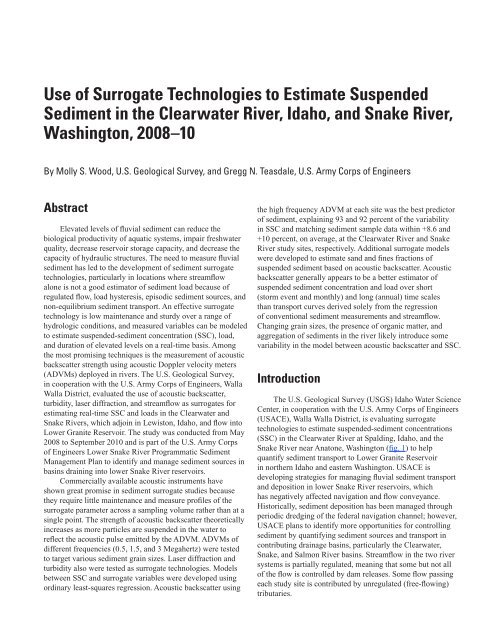Report PDF (3.7 MB) - USGS
Report PDF (3.7 MB) - USGS
Report PDF (3.7 MB) - USGS
You also want an ePaper? Increase the reach of your titles
YUMPU automatically turns print PDFs into web optimized ePapers that Google loves.
Use of Surrogate Technologies to Estimate Suspended<br />
Sediment in the Clearwater River, Idaho, and Snake River,<br />
Washington, 2008–10<br />
By Molly S. Wood, U.S. Geological Survey, and Gregg N. Teasdale, U.S. Army Corps of Engineers<br />
Abstract<br />
Elevated levels of fluvial sediment can reduce the<br />
biological productivity of aquatic systems, impair freshwater<br />
quality, decrease reservoir storage capacity, and decrease the<br />
capacity of hydraulic structures. The need to measure fluvial<br />
sediment has led to the development of sediment surrogate<br />
technologies, particularly in locations where streamflow<br />
alone is not a good estimator of sediment load because of<br />
regulated flow, load hysteresis, episodic sediment sources, and<br />
non-equilibrium sediment transport. An effective surrogate<br />
technology is low maintenance and sturdy over a range of<br />
hydrologic conditions, and measured variables can be modeled<br />
to estimate suspended-sediment concentration (SSC), load,<br />
and duration of elevated levels on a real-time basis. Among<br />
the most promising techniques is the measurement of acoustic<br />
backscatter strength using acoustic Doppler velocity meters<br />
(ADVMs) deployed in rivers. The U.S. Geological Survey,<br />
in cooperation with the U.S. Army Corps of Engineers, Walla<br />
Walla District, evaluated the use of acoustic backscatter,<br />
turbidity, laser diffraction, and streamflow as surrogates for<br />
estimating real-time SSC and loads in the Clearwater and<br />
Snake Rivers, which adjoin in Lewiston, Idaho, and flow into<br />
Lower Granite Reservoir. The study was conducted from May<br />
2008 to September 2010 and is part of the U.S. Army Corps<br />
of Engineers Lower Snake River Programmatic Sediment<br />
Management Plan to identify and manage sediment sources in<br />
basins draining into lower Snake River reservoirs.<br />
Commercially available acoustic instruments have<br />
shown great promise in sediment surrogate studies because<br />
they require little maintenance and measure profiles of the<br />
surrogate parameter across a sampling volume rather than at a<br />
single point. The strength of acoustic backscatter theoretically<br />
increases as more particles are suspended in the water to<br />
reflect the acoustic pulse emitted by the ADVM. ADVMs of<br />
different frequencies (0.5, 1.5, and 3 Megahertz) were tested<br />
to target various sediment grain sizes. Laser diffraction and<br />
turbidity also were tested as surrogate technologies. Models<br />
between SSC and surrogate variables were developed using<br />
ordinary least-squares regression. Acoustic backscatter using<br />
the high frequency ADVM at each site was the best predictor<br />
of sediment, explaining 93 and 92 percent of the variability<br />
in SSC and matching sediment sample data within +8.6 and<br />
+10 percent, on average, at the Clearwater River and Snake<br />
River study sites, respectively. Additional surrogate models<br />
were developed to estimate sand and fines fractions of<br />
suspended sediment based on acoustic backscatter. Acoustic<br />
backscatter generally appears to be a better estimator of<br />
suspended sediment concentration and load over short<br />
(storm event and monthly) and long (annual) time scales<br />
than transport curves derived solely from the regression<br />
of conventional sediment measurements and streamflow.<br />
Changing grain sizes, the presence of organic matter, and<br />
aggregation of sediments in the river likely introduce some<br />
variability in the model between acoustic backscatter and SSC.<br />
Introduction<br />
The U.S. Geological Survey (<strong>USGS</strong>) Idaho Water Science<br />
Center, in cooperation with the U.S. Army Corps of Engineers<br />
(USACE), Walla Walla District, is evaluating surrogate<br />
technologies to estimate suspended-sediment concentrations<br />
(SSC) in the Clearwater River at Spalding, Idaho, and the<br />
Snake River near Anatone, Washington (fig. 1) to help<br />
quantify sediment transport to Lower Granite Reservoir<br />
in northern Idaho and eastern Washington. USACE is<br />
developing strategies for managing fluvial sediment transport<br />
and deposition in lower Snake River reservoirs, which<br />
has negatively affected navigation and flow conveyance.<br />
Historically, sediment deposition has been managed through<br />
periodic dredging of the federal navigation channel; however,<br />
USACE plans to identify more opportunities for controlling<br />
sediment by quantifying sediment sources and transport in<br />
contributing drainage basins, particularly the Clearwater,<br />
Snake, and Salmon River basins. Streamflow in the two river<br />
systems is partially regulated, meaning that some but not all<br />
of the flow is controlled by dam releases. Some flow passing<br />
each study site is contributed by unregulated (free-flowing)<br />
tributaries.
















